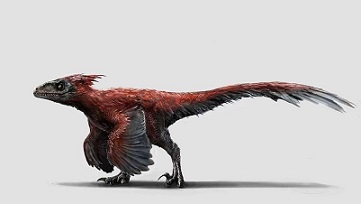
Pyroraptor, the fire thief, is a fascinating Dinosaur from the Late Cretaceous period. Its name conjures images of speed and stealth, and indeed,Pyroraptor is known for its potential agility and hunting prowess. In this 500-word exploration, we will delve into its classification, physical characteristics, habitat, behavior, and its significance in the world of paleontology.
Pyroraptor is classified as a dromaeosaurid dinosaur, a group commonly known as raptors. These dinosaurs are characterized by their sharp claws, bipedal stance, and predatory lifestyle. The first fossils of Pyroraptor were discovered in the late 20th century in the Pyrenees Mountains of France, which is how it got its name, combining pyro (fire) with raptor (thief).
| Name: | Pyroraptor dinosaurs |
| Size: | Around 5.9 feet (1.8 meters) in length. |
| Main Facts: | Pyroraptor was a swift, agile predator with sharp claws, likely hunting small prey in the Late Cretaceous of Europe. |
Pyroraptor was a relatively small dinosaur, measuring about 5.9 feet (1.8 meters) in length. Its body was lightweight and streamlined, ideal for swift movement. It had long, slender legs, suggesting it was an agile runner. Like other dromaeosaurs, Pyroraptor had a large, curved claw on each foot, believed to be used for hunting and gripping prey.
Its teeth were serrated and sharp, adapted for tearing into the flesh of prey animals. The shape of its skull and jaw indicate it was likely a carnivore, feeding on smaller animals.

Pyroraptor lived during the Late Cretaceous period, and its fossils have been found in rocks that suggest it inhabited a coastal environment. This environment would have been home to various forms of plant and animal life.
One of the most intriguing aspects of Pyroraptor is its potential hunting behavior. Its lightweight build, long legs, and large sickle-shaped claws indicate it may have been an agile predator, capable of chasing down and ambushing its prey. While the exact prey of Pyroraptor is speculative, it likely hunted smaller animals such as reptiles, birds, or small mammals.
Pyroraptor holds significance in paleontology for several reasons:
Pyroraptor adds to the understanding of dromaeosaurid diversity, showcasing the range of body sizes and adaptations within this group. Its relatively small size contrasts with larger raptors like Velociraptor.
Fossils of Pyroraptor provide insights into the Late Cretaceous ecosystems of Europe, shedding light on the coexistence of different dinosaur species and their roles in the food chain.
The potential agility and hunting behavior of Pyroraptor contribute to our understanding of theropod predatory strategies, particularly among smaller carnivorous dinosaurs.
Pyroraptor, a Late Cretaceous dromaeosaurid, was a small, agile dinosaur measuring around 5.9 feet in length. It featured a streamlined body with long, slender legs, designed for swift movement and potentially hunting. Pyroraptor had large, curved claws on its feet, believed to be used for capturing and gripping prey.
Its serrated teeth and jaw shape suggested it was a carnivore, likely preying on smaller animals. Fossils of Pyroraptor have been discovered in the Pyrenees Mountains of France, shedding light on its existence and role as a small, agile predator in the prehistoric ecosystems of Europe.
Pyroraptor, like many other dinosaurs, belongs to the theropod group, characterized by their bipedal stance, sharp teeth, and carnivorous diet.
Pyroraptor, similar to other theropods, was a carnivore, preying on smaller animals. Its sharp teeth and claws were adapted for hunting and tearing flesh.
Pyroraptor lived during the Late Cretaceous period, a time when various theropod species thrived. This temporal overlap allowed for competition and niche differentiation among these predators.
Pyroraptor was relatively small, measuring about 5.9 feet in length, in contrast to larger theropods like Tyrannosaurus rex, which could reach lengths of over 40 feet.
Pyroraptor likely employed agility and speed for hunting smaller prey, whereas larger theropods like T. rex relied on strength and ambush tactics.
While Pyroraptor possessed large sickle-shaped claws on its feet, they were smaller in comparison to the massive claws of some larger theropods like Deinonychus.
Pyroraptor fossils have been found in Europe, specifically in the Pyrenees Mountains, while many other theropods inhabited different continents.
Pyroraptor may have occupied a different ecological niche, preying on smaller vertebrates, while larger theropods targeted larger prey or scavenged.